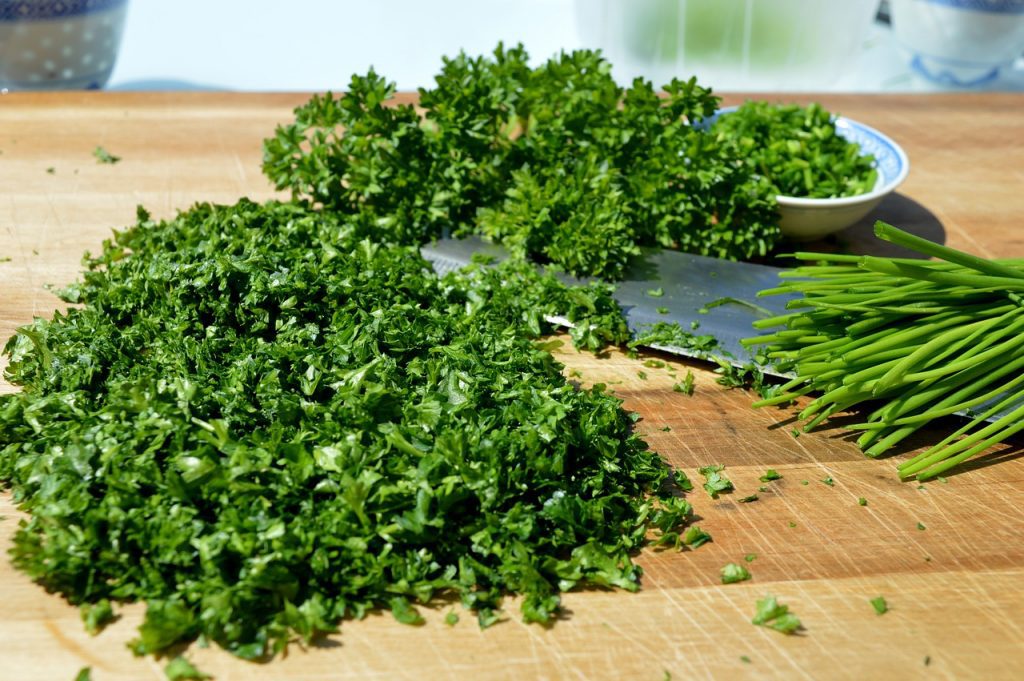The parsley is a popular herb, available at every greengrocer’s, and a staple in many of our dishes. Its root, the turnip, is an essential ingredient in broth. Let’s get to know it better and see what delicious things you can make with it!
The Latin name petroselium comes from the fusion of the Greek words petros (rock, stone) and selion (plant). It first appeared in Roman dishes and soon became so popular that the man who dipped himself in everything was called parsley.
There are two types of parsley: one is the root parsley, the root of which is the popular turnip or simply known as the root vegetable. The other is grown specifically for its tasty green leaves. Not only does it taste delicious, parsley is also an excellent garnish for the edges of a flower or vegetable bed and looks great on a plate.
Not just for decoration!
Parsley’s fresh flavour enhances dishes, but it’s best added at the end of cooking to preserve its aroma and vitamins. The leaves can be clipped to make an excellent garnish for main dishes, or chopped to add a new dimension to soups, stews and roasts.
After buying, don’t just put it in a glass of water, but put the water in the fridge. Better still, fill a sealable plastic box half full of water and soak the parsley in it, then put it in the fridge. If you change the water, it will stay fresh for weeks.
It freezes well and, like so many other herbs, can be preserved in small glass jars, layered with salt.
The root – or turnip
With a sweet, fresh, sometimes slightly pungent flavour and spicy fragrance, the root vegetable is most often used in vegetable and meat soups and sauces. The peel is easiest to remove with a potato peeler. It is more similar to parsnips and turnips. It is low in calories but rich in mineral salts, iron and potassium. It can be stored in the fridge for weeks.

Fresh Parsley, but lots of
Parsley is an essential ingredient in meat and vegetable soups. It’s often used in stuffings for meat and egg dishes, and can also be sprinkled on green salads.
Fresh spring snap pea soup and parsley taste like heavenly flavor harmony, and parsley new potatoes are a must in spring. Have you tried parsley pesto? You’ll find the recipe at the end of this article.
What are the health benefits of parsley?
Loss of appetite? Sight problems? Parsley improves your eyesight and increases your appetite! It’s also good for ear problems and a must-have herb for allergy sufferers. It is also a blood purifier and stimulates kidney function. Many people also use parsley to treat insect bites, rubbing fresh parsley over the bite site. It also has lots of vitamins C and E, essential oils, and flavions. You can also drink it as a tea: boil 2 teaspoons of parsley leaves or roots, then strain after 15 minutes.
Parsley pesto
Ingredients:
20 dkg parsley
2 handfuls of walnut kernels
half a handful of grated Parmesan cheese
2 cloves of garlic
2 dl extra virgin olive oil
salt
freshly ground pepper
Preparation. Add the walnuts, peeled garlic and cheese, toasted in a dry pan until fragrant. Puree the whole mixture and slowly drizzle in the olive oil.
Finally, season with salt and pepper, pour into small jars, cover with foil. (Store the opened jars in the refrigerator.)
Last updated: September 24, 2023



Comments are closed.